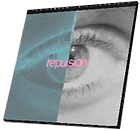

France suspense
1965
bw 104 min.
Director: Roman Polanski
CAV: $99.95 - available
2 discs, catalog # CC1387L
In 1965, Repulsion
was greeted as a brilliant, grisly potboiler that gave the thirty-two-year-old
Polish filmmaker Roman Polanski commercial entree to the West. Some viewed it as
Polanski's riposte to Hitchcock's Psycho. Three decades later, it's
evident that Polanski was always drawn to existential horror, and that his lucid
moviemaking owes as much to Hollywood's master writer-directors as to visual
maestros like Hitchcock. After Repulsion premiered, Polanski told
Cahiers du Cinema, "I like to shut myself up. I remember: when I was
twelve, fourteen, I liked atmospheres that came from . . . what do I know?
Ultimately enclosed atmospheres, stifling . . . and [I] liked films like [Billy
Wilder's] The Lost Weekend . . ."Repulsion could be
subtitled The Lost Fortnight. Centered on a beautiful schizophrenic
instead of a dapper alcoholic, with a backdrop of swinging London instead of
wartime New York, it's a horror movie, not a "problem" movie. But it has
the same suspense hook as Wilder's Oscar-winner: a sick but deceptively
presentable person (Catherine Deneuve) is left alone in an apartment usually
shared with a sibling (Yvonne Furneaux). Deneuve in Repulsion, like Ray
Milland in Weekend, scrapes psychic bottom in isolation; she, like him,
has scary hallucinations that emanate from the cracks in walls. And Polanski's
observant style owes a debt to Wilder's. These directors rely on concrete detail
to convey characters' fluctuating senses. Their ultra-conscious technique puts
audiences into the movie equivalent of a headlock.
In Weekend, Milland
maneuvers his way into solitude so he can slake his thirst; his brother and
girlfriend are on to him. But in Repulsion, Deneuve alone intuits how
loony she'll get--in vain, she begs her sister to stay with her. Even the
sister's shrewd married boyfriend (Ian Hendry), who suggests that Deneuve should
"see a doctor," thinks she's merely "a bit strung up." Unchecked
and unnoticed, Deneuve's illness transforms the apartment into
nightmare-land.
In his autobiography, Roman by Polanski, the director
treats Repulsion rather harshly, his memory colored by his constant fight
for more time and money. "Of all my films," he wrote,
"Repulsion is the shoddiest--technically well below the standard I try
to achieve." He knew he could finance a horror movie and gain some box-office
clout; that's why he and his cowriter, Gerard Brach, "included bloodcurdling
scenes that verged on horror film clichés. Any originality we achieved
would have to come through in our telling of the story." But Polanski and his
team (especially cinematographer Gilbert Taylor) did come through. Only a
confessed claustro-phile like Polanski could have created this skin-crawling
claustrophobic thriller. Only a man of his violent and erotic imagination could
have arrived at its queasy incarnations of sexual disgust.
From the opening
moments, when the camera emerges from one of Deneuve's eyeballs, Polanski
alternately shows the world as it is and the world according to his psycho. As in
his other "evil apartment" movies, Rosemary's Baby (1968) and
The Tenant (1976), he depicts everyday callousness scarring vulnerable
protagonists. Deneuve works as a manicurist in an antiseptic beauty parlor. The
job underscores her own blank prettiness, which blinds people to her weirdness. A
thread of deadpan feminist satire runs through Polanski's narrative. John Fraser
plays the polite, romantic "smooth boy" who fancies this most anti of
anti-heroines and never figures out why she won't return his kiss. When he
declares that he's "miserable" without her, his passion seems ludicrous,
since it's based only on her blonde dreaminess. (She puts him out of his misery.)
Later, when Deneuve drops even deeper into dementia, the landlord (Patrick
Wymark) comes to collect overdue rent. He chalks up the chaos and clutter
(including a moldering skinned rabbit) to feckless youth. He proposes swapping
rent for personal services--before she takes care of him for good.
Deneuve's
bad dreams of rape and entrapment, and the panicky murders she commits, are less
graphic than similar episodes in (say) the Nightmare on Elm Street series.
What gives them an undiminished fright quotient is Polanski's straight-razor
intelligence. Repulsion is an inspired textbook on the use of performance,
sound and image to convey bizarre mental states. Deneuve does the best acting of
her career. She invests this pale manicurist with an underlying tautness that
jumps out in gestures like busted springs.
Polanski poses her in an expressive
frame. When Deneuve lies awake listening to her sister come to orgasm, Polanski
pulls the camera back slowly; visually as well as aurally, her moans fill
Deneuve's room. Throughout, Gil Taylor adapts his gliding yet hyper-realistic
photographic style to Deneuve's manias; in a split second, buskers in the street
or lines in the pavement turn portentous. Even the dated special effects retain
their emotional potency--when hands burst out of the apartment walls and grab
Deneuve's body, Polanski anticipates the dehumanization of sex in half a dozen
current magazine covers.
Polanski's tough-mindedness escalates the terror. He
and Deneuve bring out the tinge of arrogance in her craziness. In the final shot,
he closes in on a family portrait that captures her as a girl. The last line of
the script refers to "her beautiful and proud, implacably vague child's eye,
where madness had already gained the day."
--Michael Sragow
CREDITS
Producer: Gene Gutowski
Director: Roman Polanski
Screenplay by Roman Polanski, Gerard Brach, David Stone
Cinematographer
Gilbert Taylor
Editor: Alastair McIntyre
Music composer by Chico
Hamilton
Art direction: Seamus Flannery
TRANSFER
Repulsion was transferred from a 35mm fine-grain master print and the original
negative in its original aspect ratio of 1.75:1. The sound was mastered from a
3-track magnetic mono master.




